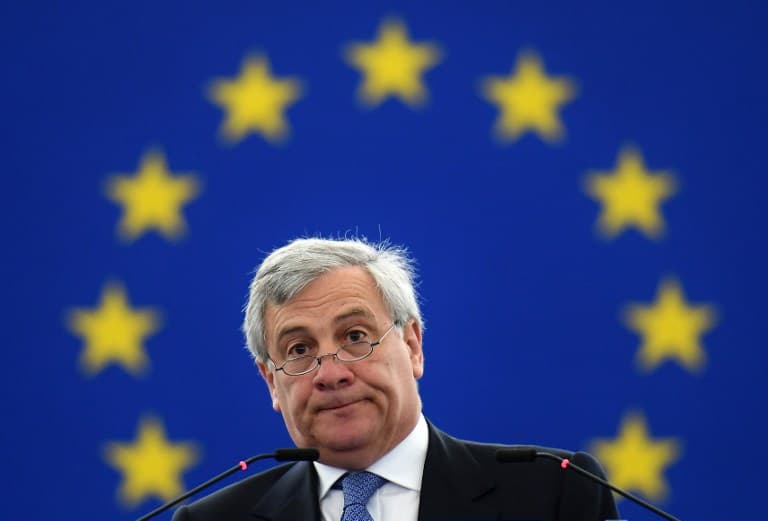EU warns against euroscepticism as populists prepare to govern Italy

EU leaders expressed concern on Friday about the rise of populism within the bloc, fuelled by the migrant crisis, as Italy came a step closer to forming its first anti-establishment government.
"Being a good Italian also means being a good European citizen. It needs to be repeated out loud, especially now," EU parliament head Antonio Tajani said at the State of the Union conference in the Tuscan city of Florence.
Italy's populist Five Star Movement and far-right League party are currently locked in negotiations to form a coalition to lead the country. Should they succeed, the new government would represent a significant change in policy for the Eurozone's third largest economy whose outgoing government is pro-European and centre-left.
The nationalist League is particularly eurosceptic and has advocated renegotiating European treaties, and insisted the euro is doomed to fail.
"Leaving the single currency would be shooting oneself in the foot," said Tajani, in what appeared to be a direct warning to the League.
READ ALSO:
Addressing the conference, European Commission President Jean-Claude Juncker said he was worried about the feelings of "resentment" in Europe generated by the arrival of millions of migrants on European shores in recent years.
This resentment "gave populists and nationalists the material they needed to undo solidarity" in Europe, Juncker said, adding that he was shocked by the "ruptures and cracks" that had emerged during the migrant crisis between EU member states.
"The Italian and Greek people asked loudly for more solidarity because you can not leave countries all alone ... unfortunately our response was too late," said Juncker referring to the burden felt by Europe's southern nations who have shouldered the majority of the responsibility for the new arrivals.
Both the League and M5S have promised to crack down on immigration in Italy.
On Thursday, Italian President Sergio Mattarella was also in Florence and warned against bowing to nationalism.
"To think that we can get by alone is a pure illusion or, worse, a deliberate deception aimed to sway public opinion," he said.
READ ALSO: Italy could have a government by Sunday

Matteo Salvini (L) and Luigi Di Maio. Photos: Filippo Monteforte/Alberto Pizzoli/AFP
Comments
See Also
"Being a good Italian also means being a good European citizen. It needs to be repeated out loud, especially now," EU parliament head Antonio Tajani said at the State of the Union conference in the Tuscan city of Florence.
Italy's populist Five Star Movement and far-right League party are currently locked in negotiations to form a coalition to lead the country. Should they succeed, the new government would represent a significant change in policy for the Eurozone's third largest economy whose outgoing government is pro-European and centre-left.
The nationalist League is particularly eurosceptic and has advocated renegotiating European treaties, and insisted the euro is doomed to fail.
"Leaving the single currency would be shooting oneself in the foot," said Tajani, in what appeared to be a direct warning to the League.
READ ALSO:
Addressing the conference, European Commission President Jean-Claude Juncker said he was worried about the feelings of "resentment" in Europe generated by the arrival of millions of migrants on European shores in recent years.
This resentment "gave populists and nationalists the material they needed to undo solidarity" in Europe, Juncker said, adding that he was shocked by the "ruptures and cracks" that had emerged during the migrant crisis between EU member states.
"The Italian and Greek people asked loudly for more solidarity because you can not leave countries all alone ... unfortunately our response was too late," said Juncker referring to the burden felt by Europe's southern nations who have shouldered the majority of the responsibility for the new arrivals.
Both the League and M5S have promised to crack down on immigration in Italy.
On Thursday, Italian President Sergio Mattarella was also in Florence and warned against bowing to nationalism.
"To think that we can get by alone is a pure illusion or, worse, a deliberate deception aimed to sway public opinion," he said.
READ ALSO: Italy could have a government by Sunday

Matteo Salvini (L) and Luigi Di Maio. Photos: Filippo Monteforte/Alberto Pizzoli/AFP
Join the conversation in our comments section below. Share your own views and experience and if you have a question or suggestion for our journalists then email us at [email protected].
Please keep comments civil, constructive and on topic – and make sure to read our terms of use before getting involved.
Please log in here to leave a comment.